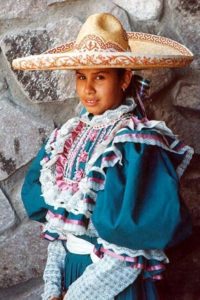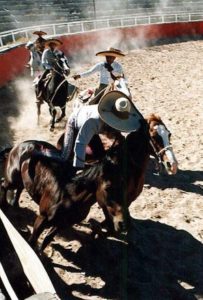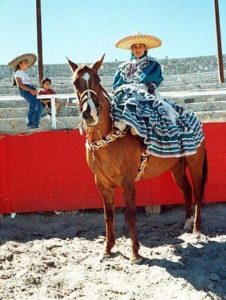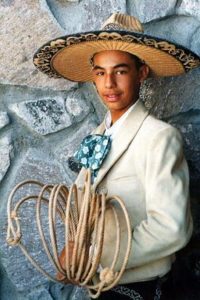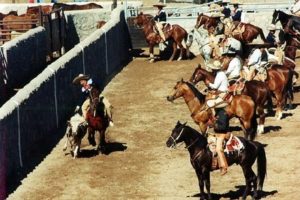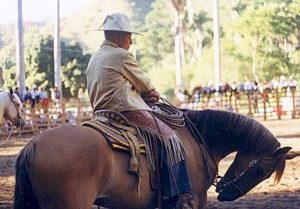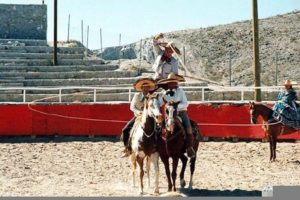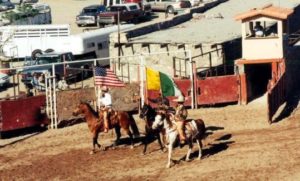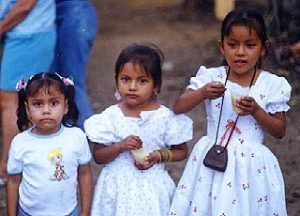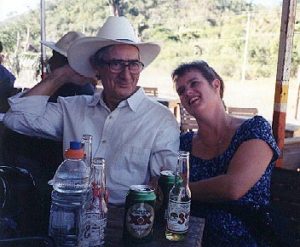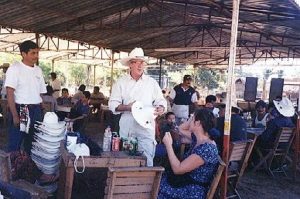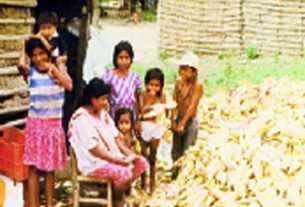In rural Canada, I live close to the land and to a farming lifestyle that was once traditional. Therefore, when I’m in Mexico the countryside draws me to its peoples and traditions. It seemed natural to me to seek more information about the charro (cowboy), heir to Mexico’s charrería or equestrian tradition. The search led me to people on both sides of the border.
I discovered that charros symbolize Mexican ranch life in much the same way Clint Eastwood and the Marlboro Man represent the American west. A combination of cowboy and knight-errant, the charro is valiant and skillful. On horseback, he gallops across movie screens, appears in literature, and is the hero of songs and even modern advertising. But who or what does the Mexican charro really symbolize, I wondered.
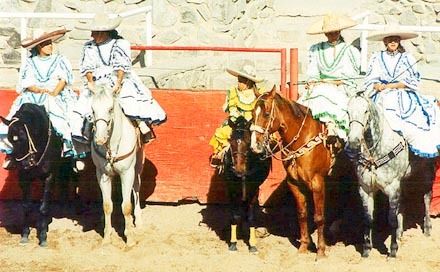
Several years ago a Mexican friend, Federico, introduced me to a charro. In Guadalajara, he took my teens and myself to lunch at a restaurant. He greeted the owner, a legendary charro, and later pointed out many photos of the man gracing the restaurant walls. Mouth-watering comida campirana or countryside food was slowly cooking over coals in an open hearth. A musician in charro costume sang, while roving between tables. When he reached us, Federico joined the guitarist in a passionate rendering of a ballad. Afterwards when the house band launched its tunes, Federico flashed a smile, exclaiming, “My friend who owns this restaurant was once also a famous recording star.” After fielding my first questions he promised, “ Amiga. Next year when you visit Guadalajara, we will go to a real charreada!”
In the meantime, I brushed up on the history of the charreada. I learned that Spanish conquistadors introduced Mexico’s natives to horses and cattle. The charreada evolved from informal contests the vaqueros or cowboys held to show off their ranching skills, such as bronco riding and roping. The sport can best be described as living history, an art form drawn from the demands of a working life.
By the beginning of the twentieth century almost all the events you see at a charreada today had been developed. Modern charros can be ranchers, business people and professionals banded together in associations to preserve charrería traditions. Once the charreada moved to the city, it became an exacting, rugged sport with strict rules followed by both men and women.
During the charreada the values of rural life are affirmed. However the performers, their families and audiences are not naïve. They understand that culture is by definition dynamic and changing. It adapts to new circumstances and needs. Today, in the midst of change, tensions and uncertainties, many feel a need to be involved with their heritage by becoming charros and charras. This is a buffer against competing attractions like drugs, gangs and consumerism. The sport demands constant training and practice. Good performance fosters positive self-image.
“Anyone can be a good horseman. It just takes practice, but that’s not what charrería is about. Some belong only to compete in the arena, but that’s not being a charro. Charrería is a way of life outside the arena as well as in. It’s family and social traditions and culture.” said Raúl E.Gaona, Vice-president San Antonio Charro Association
The following year, 1998, I could spend only a few days after Christmas in Guadalajara. Two of my teens and I rode the overnight bus from Manzanillo on the coast, up to the high plain of Jalisco, arriving at 8 a.m. Sunday morning. From the bus station on the outskirts of Guadalajara, we went straight to our hotel. Josh and Rose tumbled immediately into the comfortable beds and fell asleep. Charreadas generally start by 10 a.m.
The city of Guadalajara takes pride in having the oldest lienzo, or performing arena and charro associations in Mexico. Jalisco has been the host for more national charro congresos and championship competitions than any other state. My guidebook listed two lienzo in the city. I called a cab and the driver attempted to find the one nearest our hotel.
Shut and bolted, an enormous wooden gate barred the entrance to the Lienzo Charro Zerme ño Padilla. In Spanish my cabby informed me, “So sorry, Señora. The lienzo is closed. Perhaps you will find a charreada here next Sunday.”
I didn’t have another Sunday to spend in Guadalajara. Was I this close to the charrería tradition and going to miss it completely? Was there another chance to catch a charreada? I rang my friend, Federico who expected our arrival.
“ Amiga! You are arrived. So early,” he said. I reminded him that we had discussed seeing a charreada together and told him there was no performance at Lienzo Zermeño that morning. “Never fear. I will quickly search all of the charro associations in Guadalajara on the Internet. I promised you a charreada. And I will find one. Please give me one hour to get ready.”
An hour later, Federico drove up to the hotel with his thirteen-year-old daughter, Lorena, and her twelve-year-old cousin, Elena. Their faces dropped when I told them my kids were asleep in the hotel.
Driving fast and furiously, Federico arrived at the Lienzo Charro de Jalisco just beyond the southeast side of Parque Agua Azul. This large shady green park is located about a three-dollar taxi ride, south of the central Plaza Tapatía. Since it was now well past ten, we walked swiftly across the busy street to the lienzo.
Federico studied the program and bought tickets for about three dollars each. We climbed up a wide concrete staircase that opened into the ample seating area above the lienzo. Choosing the sombra or shady side of the ring, Federico glanced at the low concrete benches.
“We will need these!” He exclaimed, renting each of us a plastic covered foam seat pad.
A man in a gleaming white embroidered shirt with a short necktie approached, selling copies of the glossy magazine, ‘Charrería, el deporte nacional.’ Federico bought me one for a souvenir. The fellow offered some extra information, “You are in luck! Today’s charreada is a double competition lasting six hours.”
A brass band at the top of the tiers raised a rousing fanfare for the next event. A young bull raced out of an open chute with a charro in hot pursuit. The man leaned an impossible distance out of his saddle, grabbing onto the bull’s tail. Neat as a whistle, the bull flipped onto his back, landing between two limed lines. With a wild twisting of hooves, he scrabbled to his feet. The small crowd applauded. Trumpets blasted a salute. The charro slowed his horse down and cantered back to the holding pens. Minutes later, the chute re-opened and a second young bull raced down the lienzo. Another charro from a competing team galloped after him. He performed the same stunning tail flip. The event continued for ten more bulls.
Meanwhile a vendor approached with beer and pop on ice in a large plastic bucket. Charreada watching is thirsty work. Savoring a cool swallow in the interlude between events, I studied my friend as he chatted with his girls. Dark short hair. Strong handsome features in a lightly tanned face. Eyes that flash passionately. A mouth quick to describe his feelings, his ideas, his life.
Four years before, Federico and I met over the internet. The intercambio (exchange) resulted in both of us overcoming prejudices and stereotypes about each other’s culture and becoming good friends. Today we sat together as learning spectators to the charrería tradition.
Around us, fans applauded and cheered when scores were announced. Loyalty is expressed for favorite teams often made up of family members. But regardless of team loyalty, applause and energetic music reward any excellent performance. Superb form and stylish flair are factored into the intricate scoring system for each event. However perfection in execution or score is nearly impossible to achieve at either the individual or the team level. The ideal inspires the competitors to stretch their abilities, cooperate fully and take risks for the pure glory of charrería. The heroic urge links the competitive charreada to the historic role of the charro as national symbol, gentleman, patriot, and equestrian sportsman.
Each charro performs in traje or costume. This can be a Windsor or butterfly necktie, close-fitting black trousers, gaiters, dark leather vest, and a short jacket in the same dark color, with a set of buttons and embroidered filigree. His hat is the Adalusian style, a wide-brimmed felt sombrero with thick ribbon adornments and braid in gold, silver or vivid colors. In a less formal charreada the charro might wear a simple felt or palm hat, a chamois skin jacket or shirt and chamois ski trousers with three cuff links on each side, brown or reddish brown shoes, necktie and a revolver case.
The next competing charro brought his horse to an elegant standstill and unraveled a long coil of rope from his saddle. Tall and thin, his legs sheathed in tight pants, his torso in leather, sharp faced, he threw the long rope into the air as if it were a ribbon. The lasso moved up around his body, imprisoning him in circles and then fell about him, like a descending halo. On the sky and earth, he designed, arabesques, corollas and calyxes. This task is called floreo de reata or ‘making flowers.’ After his intricate flourishes, the charro returned his lasso to his saddle and cantered back. Another eleven competitors followed, weaving more flowers with thin hard ropes.
More than two hours had passed. The girls twitched in their seats. Admittedly, the concrete under my seat grew harder by the minute. Thinking also that my children might be waking up back at the hotel, I asked Federico, “This has been great. But would you mind if we went soon?”
My friend had read the squirming body language but couldn’t resist a tease. “A double charreada is too much for a gringa!” Adding with a smile as warm as Mexico, “Too much for this Mexican, too!”
The charrería tradition is dynamic and difficult to fully describe in words. The charreada is riveting in the heat of action and reflective in the interludes. This strictly amateur sport is family and community centered. Winning is second to cooperation and respect for the whole charrería tradition. The point of the competitions is to access levels not available to the single individual. In effect, performers mirror the ideals of community cooperation. Although often impossible to achieve in ordinary life, such ideals are reflected in the patterned, high-velocity, stylized movements of the competitive events. In the charreada, style and precision reflect the emphasis Mexican culture places on baroque richness, colorful decoration, elegance and mastery.
The charreada is divided into nine scored events called suertes. They are:
- cala: individual reining competition
- piales en el lienzo: roping wild mares
- coleaderos: tailing wild bulls
- terna en el ruedo : team bull roping
- jinete de novillos: bull riding
- jinete de yeguas: wild mare riding
- manganas a pie: roping wild mares from on foot
- manganas a caballo: roping wild mares from horseback
- paso de la muerte: leaping to and riding a wild mare
Young women, the Adelitas or charras form mounted drill teams of 7 or 8 called escaramuzas or the skirmish. An escaramuza performs high-speed precision patterns riding sidesaddle while demonstrating bravery, equestrian skills, teamwork, and femininity. Women are organized into over three hundred performing groups.
Charros and charras are the heroes of a drama involving an elaborate system of etiquette and rules. The performers concentrate their energies into executing their roles, unifying the historic past and present. Through these roles and costumes, the performers gain control, moving beyond fear of physical risk. High scores validate skill and courage. Audience acclaim affirms community approval. Self-assessment confirms status against competitors and within the association.
Charreadas convey a sense of order and solidarity. Persons and groups bond socially. Inequalities are shed with street clothes and the donning of costumes. Although individual personalities and histories are not forgotten, the performance role takes precedence over personal idiosyncrasies and conflicts. Within the time frame of the charreada, performers and audience set aside their contending interests, duties, and purposes. Away from the ‘business’ of making a living, a sense of comradeship and communion is achieved. Other lively fiesta rituals follow the competitions…eating, drinking, dancing, visiting and courting.
There are currently nearly nine hundred charrería associations in Mexico and more than one hundred and eighty in the United States. In the Southwest where Mexican Americans make up a significant proportion of the population, the charrería is relatively unknown despite the fact that charreadas are staged most Sundays from Dallas to Los Angeles.
The charrería tradition gives both Mexicans and those of Mexican descent, a source of pride. The centuries-old tradition brings together working skills, training and discipline, horsemanship, community cooperation, aesthetic expression, social protocols, gender relationships, music and dance, and symbolic reenactment of Mexican values and activities.
CHARRERIA ASSOCIATIONS:
- FEDERACION MEXICANA DE CHARRERIA, A.C.
(Mexican Federation of Charros – largest organization of charro associations in Mexico) https://www.codeme.org.mx/charros/ (Spanish) - Their national office and museum are located in the historic center of Mexico City at Calle Isabel la Católica 108, corner with José Ma. Izazaga, México City 1 D.F., C.P.060080, Tel. (5) 709-47-93, 709-48-23, 709-50-32. Fax (5) 709-48-38.
- ASOCIACION NACIONAL DE CHARROS
https://www.nacionaldecharros.com - FEDERATION of CHARROS U.S.
United States branch of Mexican Federaction of Charros A.C., formed in 1991 and not formally affiliated with the Mexican Federation of Charros
CHARRERIA WEB SITES IN ENGLISH AND SPANISH
- https://homepages.go.com/homepages/c/h/a/charra17/
Charra de Guadalajara’s personal web site featuring the origin, las suertes, charras or women, the saddle and links in the charrería - https://www.charreria.com.mx Site for the magazine, ‘Charrería, ‘El Deporte Nacional’ (the national sport) in Spanish
BOOKS ABOUT THE CHARRERIA TRADITION
- Kathleen Mullen Sands, “Charrería Mexicana An Equestrian Folk Tradition,” 1993
This first major English-language interpretation of charrería describes the evolution of this equestrian tradition, highlighting the role of horsemen and women throughout Mexico’s history. For those who believe cowboy culture and rodeo represent historic horsemanship in the United States, Charrería Mexicana reveals a festival of equal complexity and distinction. - James Norman, “Charro: Mexican Horseman,” 1969
- José Cisneros, “Riders Across the Centuries: Horsemen of the Spanish Borderlands, ” 1984
- José Alvarez del Villar, “La Charrería Mexicana,” 1987
- Octavio Chávez, “La Charrería: Tradicion Mexicana,” Instituto Mexiquense de Cultura, Toluca,” 1991
MAJOR DATES TO EXPERIENCE CHARRERIA IN MEXICO:
September 14, National Charro Day
– many fiestas take place with parades and patriotic celebrations at national and regional war memorials
Mid-October, finals are held in a city in Mexico chosen by a vote of the Mexican federación membership.
December 12, The patron of Mexico, Virgen of Guadalupe is honored on or near this date all over Mexico at The Guadalupano
February 5, Mexican Constitution Day the Charro Espectacular is held at the RaceTrack of the Americas in Mexico City.
MAJOR LIENZOS IN MEXICO
- Lienzo Rancho Grande de la Villa, Mexico City
- Lienzo Pedregal, outskirts of Mexico City
- Lienzo Charro de Jalisco 477 Calz, Las Palmas tel (3) 619-3232 near southeast side of Parque Agua Azul, Guadalajara, Jalisco
- Lienzo Charro Zermeño Padilla near Parque de Colomos northwest section in Guadalajara, Jalisco
Watch for posters, ask at your hotel desk or the tourist information offices in cities like Guadalajara Tel. (3) 614-8686 for details and dates of espectáculos or shows. For example, the international tourism destination Puerto Vallarta, Jalisco has eight charro stadiums, two in Puerto Vallarta, El Pitillal, La Mojonera and one each in Ixtapa, Las Juntas.
PHOTO CREDIT All photos in this article taken by Gilbert Kellner https://www.photomonthly.com at Lienzo Charro “El Pedregal” 28 miles from El Paso, TX. Take I-10 to the Vado, NM exit and turn to the east. After about 1/4 mile the pavement ends. Signs point the way from there to the arena.
This lienzo is owned and operated by Miguel and Thelma Castro. Their children, Miguel Jr.,Daniel and Thelma Annette participate in the Charrería. The family travels throughout the Southwest United States putting on demonstrations. Photos from practice sessions accompanying this article courtesy of the Castro family.
This is part 1 of 5
- Introduction to the Series
- Part 1: Charreada in Guadalajara
- Part 2: Receiving End of a Mexican Rodeo (Recibímiento á Las Fiestas Taurinas)
- Part 3: The Bullfight and Cantinflas
- Part 4: Cantinflas, the Castillo and Ponche in the Plaza
- Part 5: Gold Trail to Santa María del Oro, Nayarit

